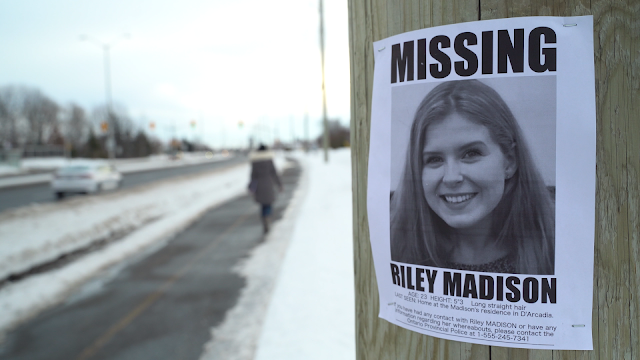- Get link
- X
- Other Apps
- Get link
- X
- Other Apps
 |
| One of the flyers asking for help finding Riley. Photo: Andrew J.D. Robinson. |
What starts as a true crime documentary about the disappearance of Riley Madison and the friends and family she left behind gradually evolves into a larger story of the many who go missing from the small town of D'Arcadia. The story evolves through a series of found footage interviews, video calls, private chats, and social media posts.
Andrew J.D. Robinson wrote and directed the feature-length mockumentary. Robinson has made a name for himself as the founder and programmer of the 15 Second Horror Film Challenge and the page moderator for the Facebook group Horror Filmmakers. We Are the Missing is his first feature-length film, clocking in at around 83 minutes.
The ability to tell a compelling story and build tension in few scenes is certainly an admirable one, and Robinson's talents in this regard are undeniable. After a short montage of photos and some voice over explaining, "It could happen to anyone," the first half an hour or so is dedicated to building the story of Riley's disappearance. By far the strongest part of the story, viewers witness the taped interviews of Riley's parents, her best friend, Mackenzie Porter, and her grade school teacher. We learn about Riley's friends, interests, home life, and her childhood imaginary friend, Mikey. As the individuals share their memories of life with Riley, photos and images flash across the screen. Although many of the musings sound very ordinary, a feeling of uneasy tension pervades. Unsettling details grab the attention and sound the alarm that all is not what it seems. For instance, Riley's mom, Angie Madison, enters her daughter's bedroom one day to find an extension cord going into the closet, where she discovers a coffee maker and pillows. And the teacher's memories of Mikey, the imaginary friend, may raise arm hairs. The local urban legend of Marvin Carvin also provides a humorous and very authentic touch.
All of these details combine to create a potent bit of storytelling, only marred by the fact that many of the found photos of Riley don't look like the same girl, which detracts from the overall effect. At times, the photos look like stock images, rather than real people. But the the tight focus on the key players and the realistic interviews plays like a real documentary.
 |
| Maissa Houri as Angie Madison, Riley's mother. Photo: Andrew J.D. Robinson. |
A transition then occurs as viewers finally meet Carter, the one who has been filming the documentary. She calls to solidify plans to interview the parents again, only her calls are going straight to voicemail. The story takes a turn as more people -- the people we have met -- begin to go missing, as well. This is where the project begins to become uneven and suffer. The magic juice that made earlier interviews seem authentic in the first third is a difficult-to-define blend of all-too human ways of speaking. Riley's loved ones showed sarcasm, defensiveness, anger, and vulnerability. In contrast, interviews in the next part seem melodramatic and overacted, as if some of the individuals felt this mockumentary was their big break into stardom and needed to make their moment count. When people are being interviewed about difficult topics, they don't look right into the camera like they are doing a screen test. The storytelling suffers as a result of this shift. The characters no longer seemed like real people, and this viewer was taken out of the narrative.
Two exceptions to this generalization: Mackenzie's sister, April Porter (Gabrielle Banville) and a waitress named Olive Perkins (Chantal Grace) have just the right combination of sincerity and simplicity to make their moments on screen shine, without extra pizazz.
 |
| Mackenzie Porter (Willow McGregor) is Riley Madison's best friend. Photo: Andrew J.D. Robinson. |
As the story continues to unfurl towards its conclusion, it becomes clear that the original threat to the town detected is actually something much more ephemeral and paranormal. And as suspected, the final reveal does tie finally tie into Riley's story. Unfortunately, the way in which it's done might as well have been accompanied by a flow chart or chalkboard drawing. When Olivia is filming her story, viewers are treated to a "Remember This" show-and-tell, as if viewers aren't smart enough to remember the wackier details of Riley's story. To be fair, taking a story from the disturbing but normal event of people going missing to something more large-scale and supernatural is a difficult jump to make. But even in introducing the most out-there Lovecraftian scenario, the character's reactions need to be consistent within the boundaries of the story.
One element that worked well was the musical soundtrack. End credits show many of the tracks are by Alchemilla Music, The Bobo, and TMX666. The track that plays under April's interviews is particularly hair-raising.
While We Are the Missing has some great building blocks and cast and crew display instances of talent, overall this mockumentary suffers from an uneven tone. The camera resolution also changed too many times. It would have benefited from having an overall consistent look. Perhaps it would have been better as a serial podcast or a short. The transition from making shorts to longer pieces is certainly no small task, especially when trying to keep budgets low. Robinson has great potential as a horror filmmaker, and I look forward to seeing what he does next.
Release info: Full film available on YouTube
Final rating: 2.5 out of 5
Comments